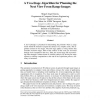Free Online Productivity Tools
i2Speak
i2Symbol
i2OCR
iTex2Img
iWeb2Print
iWeb2Shot
i2Type
iPdf2Split
iPdf2Merge
i2Bopomofo
i2Arabic
i2Style
i2Image
i2PDF
iLatex2Rtf
Sci2ools
BMVC
1998
1998
A Two-Stage Algorithm for Planning the Next View From Range Images
A new technique is presented for determining the positions where a range sensor should be located to acquire the surfaces of a complex scene. The algorithm consists of two stages. The first stage applies a voting scheme that considers occlusion edges. Most of the surfaces of the scene are recovered through views computed in that way. Then, the second stage fills up remaining holes through a scheme based on visibility analysis. By leaving the more expensive visibility computations at the end of the exploration process, efficiency is increased.
| Added | 01 Nov 2010 |
| Updated | 01 Nov 2010 |
| Type | Conference |
| Year | 1998 |
| Where | BMVC |
| Authors | Miguel Angel García, Susana Velázquez, Angel Domingo Sappa |
Comments (0)

